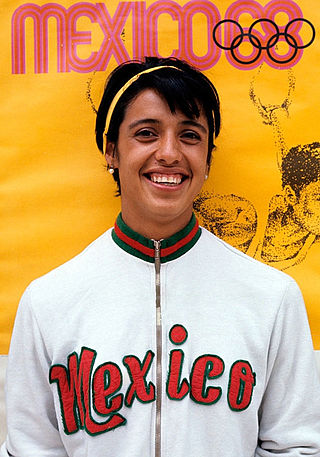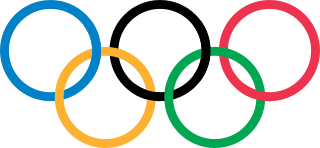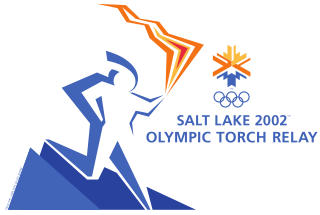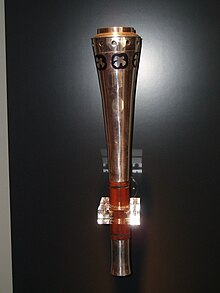The Olympic flame is a symbol used in the Olympic movement. It is also a symbol of continuity between ancient and modern games. Several months before the Olympic Games, the Olympic flame is lit at Olympia, Greece. This ceremony starts the Olympic torch relay, which formally ends with the lighting of the Olympic cauldron during the opening ceremony of the Olympic Games. The flame then continues to burn in the cauldron for the duration of the Games, until it is extinguished during the Olympic closing ceremony.
The 1968 Summer Olympics, officially known as the Games of the XIX Olympiad and commonly known as Mexico 1968, were an international multi-sport event held from 12 to 27 October 1968 in Mexico City, Mexico. These were the first Olympic Games to be staged in Latin America and the first to be staged in a Spanish-speaking country. They were also the first Games to use an all-weather (smooth) track for track and field events instead of the traditional cinder track, as well as the first example of the Olympics exclusively using electronic timekeeping equipment.

Norma Enriqueta "Queta" Basilio Sotelo was a Mexican track and field athlete. She was born in Mexicali, capital of Baja California. She came from an athletic family; her father was a cotton farmer. Her Polish coach, Włodzimierz Puzio, moved her from high jumping to hurdling. She made history by becoming the first woman to light the Olympic Cauldron. She was the last torch-bearer of the 19th Summer Olympics in Mexico City on 12 October 1968.

The Olympic Games ceremonies of the Ancient Olympic Games were an integral part of these Games; the modern Olympic games have opening, closing, and medal ceremonies. Some of the elements of the modern ceremonies date back to the Ancient Games from which the Modern Olympics draw their ancestry. An example of this is the prominence of Greece in both the opening and closing ceremonies. During the 2004 Games, the medal winners received a crown of olive branches, which was a direct reference to the Ancient Games, in which the victor's prize was an olive wreath. The various elements of the ceremonies are mandated by the Olympic Charter, and cannot be changed by the host nation. This requirement of seeking the approval of the International Olympic Committee (IOC) includes the artistic portion of opening and closing ceremonies.

The 2012 Summer Olympics torch relay was run from 19 May until 27 July, prior to the London 2012 Summer Olympics. The torch bearer selection process was announced on 18 May 2011.

The 2010 Summer Youth Olympics torch relay was run from 23 July until 14 August 2010, prior to the 2010 Summer Youth Olympics held in Singapore. The torch relay was termed The Journey of the Youth Olympic Flame, or JYOF, by the Singapore Youth Olympic Games Organising Committee (SYOGOC). It began with the traditional flame lighting ceremony in Olympia, Greece on 23 July 2010, and was followed by a 13-day round the world tour across five cities, namely Berlin, Germany; Dakar, Senegal; Mexico City, Mexico; Auckland, New Zealand; and Seoul, South Korea. Following the international leg, the torch arrived in host city Singapore on 6 August 2010 for the domestic leg.

The 2002 Winter Olympics torch relay was a 65-day run, from December 4, 2001, until February 8, 2002, prior to the 2002 Winter Olympics. The runners carried the Olympic Flame throughout the United States – following its lighting in Olympia, Greece, to the opening ceremony of the 2002 games at Rice-Eccles Stadium in Salt Lake City, Utah. The 2002 torch relay was also the 50th anniversary of the Winter Olympic torch relay, which was first run during the 1952 Winter Olympics.

The 2012 Summer Paralympics torch relay ran from 22 to 29 August 2012, prior to the 2012 Summer Paralympics. The relay began with four flames kindled on the highest peaks of the four nations of the United Kingdom, which were then brought to their respective capital cities for special events honouring the upcoming Games. For the relay proper, the four national flames were united at a ceremony in Stoke Mandeville in preparation for a final 92-mile (148-kilometre) journey to London.
The 1948 Summer Olympics torch relay was run from 17 July until 29 July 1948, prior to the 1948 Summer Olympics, held in London, United Kingdom. The relay was nicknamed the "relay of peace". It was only the second occasion that a torch relay was held for the Olympics; the first was at the 1936 Summer Olympics.
The 1976 Summer Olympics torch relay celebrated the first time that a Canadian city had hosted the Games. Convention states that the flame should be lit at Olympia in Greece and then transported to Athens, making its way onwards to the host city. On this occasion a signal was sent via satellite to transmit the flame to Ottawa where it would then make its way to the 1976 Summer Olympics opening ceremony in Montreal and a second ceremony in Kingston, Ontario.

The 2000 Summer Olympics torch relay was the transferral of the Olympic Flame to Sydney, Australia, that built up to the 2000 Summer Olympics. The torch travelled to various island nations as part of a tour of Oceania before beginning an extensive journey around Australia. For the first time the Flame was taken underwater, with a special flare-like torch taken on a dive down to the Great Barrier Reef. At the opening ceremony the cauldron was lit by Aboriginal athlete Cathy Freeman.

The 1996 Summer Olympics torch relay was run from April 27, 1996, until July 19, 1996, prior to the 1996 Summer Olympics in Atlanta. The route covered 26,875 kilometers (16,699 mi) across the United States and included a trek on the Pony Express, a ride on the Union Pacific Railroad, and a torch was taken into outer space for the first time. The relay involved over 12,000 torchbearers, including Muhammad Ali, who was chosen to ignite the Olympic cauldron.
The 1984 Summer Olympics torch relay was run from May 8 until July 28, prior to the 1984 Summer Olympics in Los Angeles. The route covered around 15,000 kilometers (9,300 mi) across the United States and involved over 3,600 torchbearers. Rafer Johnson lit the cauldron at the opening ceremony, becoming the first black athlete in history to do so. The Los Angeles Olympic Organizing Committee (LAOOC) tasked Burson-Marsteller, the public relations agency of AT&T, with the organization of the relay. The Youth Legacy Kilometer pioneered the idea of runners being nominated by the public.

The 1992 Summer Olympics torch relay was run from 5 June until 25 July, prior to the 1992 Summer Olympics in Barcelona. The route covered 5,940 kilometres (3,690 mi) and involved 9,484 torchbearers.

The 2008 Summer Olympics cauldron is the Olympic flame holder that was used during the 2008 Summer Olympics and the 2008 Summer Paralympics in Beijing, China. It was first lit on August 8, 2008, as part of the opening ceremony of the Games of the XXIX Olympiad and last extinguished as part of the closing ceremony of the games of the Paralympics on September 17. Originally located on the inside roof of the Beijing National Stadium, it was relocated to outside the stadium on the Olympic Green following the completion of the Games.
The 1988 Winter Olympics torch relay was run from November 15, 1987, to February 13, 1988, prior to the Calgary 1988 Winter Olympics.
The 1952 Summer Olympics torch relay was the symbolic transport of the Olympic flame from Olympia, Greece, to the venue of the 1952 Summer Olympics in Helsinki, Finland, where it featured as part of the opening ceremony.

The 2022 Winter Olympics torch relay was run from 18 October 2021 until 4 February 2022. After it was lit in Olympia, Greece, the torch traveled in a symbolic relay to Athens on 19 October. The Chinese leg ended in Beijing National Stadium, at the end of the opening ceremony. On 20 October 2021, it was announced that the Chinese leg will have only three days, following a series of displays of the flame in various Chinese cities, starting on 2 February, at the morning of the first day of the Chinese New Year as stage 3. Unlike the previous relays, the relay only visited the three venues clusters, the main sights of Beijing and the city of Zhangjiakou. The final torch was lit by long-distance runner Dilnigar Ilhamjan and nordic combined Zhao Jiawen.














